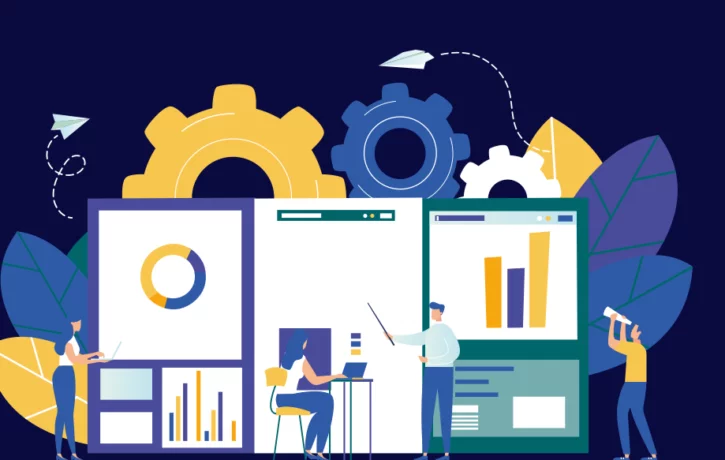You’ve invested in the most powerful workplace technology available. So why does your user onboarding look like a game of broken telephone?
When it comes to training employees on how to use new technology, many companies’ software onboarding strategies are ineffective.
Enterprises commonly rely on more experienced staff to onboard new users, despite the fact that even seasoned employees usually are not experts on the tool. When someone who only has partial knowledge of a software system onboards another, they can only teach as much as they know — the knowledge gap gets wider.
Dive Deeper: Is Poor Software Onboarding Putting Your Digital Transformation at Risk?
The old school approach to workforce learning is hurting employee performance

According to Deloitte, 80% of workforce learning happens via on-the-job interactions with peers, teammates, and managers. Sadly, this model has proved to be poor at training employees effectively.
Shift Learning has identified that only 38% of managers believe their training programs meet their learner’s needs. One of the core reasons for this is that humans aren’t reliable teachers because they can only teach the information that they know.
If the trainer doesn’t know how to perform a specific process, then he or she can’t relay that knowledge to another employee. Likewise, when a trainer is absent or ill, the learner is left in the dark with no ability to learn.
Instead, software onboarding and knowledge bases should live inside the software itself.
Five benefits of a digital software learning solution
1. The trainee can learn everything on one platform
With a software-learning tool, everything can be learned within the platform. Having tutorials and software guides accessible in one place eliminates the need for “context switching,” which can be distracting and tiresome.
Digital learning solutions, such as a Digital Adoption Platform (DAP) act as a knowledge hub that includes all the training employees need to become fluent with new technology. There is no need to waste time changing screens or searching for different documents; everything is in one place.
2. Employees have the chance to “learn in the flow of work”

Perhaps the most significant advantage of using a digital adoption platform is that employees can learn by doing. They can use on-demand tutorials to take them through new processes step-by-step.
Having educational content at the click of a button not only provides employees with more independence, but it cultivates a more effective learning experience. Employees and new hires learn on the job and access real-time support at any time they choose.
3. Building new skills is a click away
One of the perks of digital software training is that new skills are just a click away. Fast-paced learning is important given that the time an employee has for learning new skills is incredibly thin.
Deloitte estimates that 1% of a work week is all that employees have to focus on training and development.
Providing a software-based learning alternative allows employees to learn while staying productive. In practice, this means less time waiting for a trainer and more time developing new skills.
4. Unlock the benefits of contextual learning
Digital learning solutions that enable contextual learning are the most effective option. These tools teach employees how to navigate software and complete processes with real-time prompts and tutorials. With this approach, employees learn by doing, gain independence, and increase productivity.
How does it work? Training solutions that enable contextual learning use contextual factors like the employee’s position, frequent tasks, goals, and user behavior to offer custom, real-time on-screen guidance.
In other words, contextual learning provides proactive support to ensure that employees never get stuck with a crucial process.
Instantly simplify software onboarding with WalkMe. Request a demo.
5. Achieve digital adoption!
Finally, digital software learning solutions better enable your employees to achieve digital adoption. Learning independently helps reduce the stress of using new technology and builds confidence. This means your users can take advantage of the full range of capabilities on a given software platform.

Without digital adoption, employees are constrained to the basic processes that are easiest to learn and don’t have the opportunity to truly maximize your software investment.
Software training gives employees an opportunity to learn those tasks they are expected to do everyday independently. Having a software training guide at their fingertips means they won’t get lost when their trainer isn’t in close proximity.
Software training develops competency
Digital software training is a welcome alternative to the outdated model of employee-to-employee training. Instead of waiting for a trainer’s assistance, employees can run tutorials and learn new things during the course of the working day.
In enterprise environments where time is a finite resource, software training gives employees the opportunity to learn while working. The beauty of a software-based tutorial is it can be repeated as many times as needed to get the point across.
WalkMe’s Digital Adoption Platform (DAP) transforms the user experience in today’s overwhelming digital world. Using artificial intelligence, engagement, guidance, and automation, WalkMe’s transparent overlay assists users to complete tasks easily within any enterprise software, mobile application or website. Discover how a DAP can revolutionize your business.

